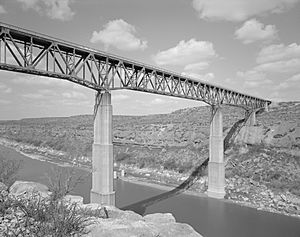Pecos River facts for kids
Quick facts for kids Pecos River |
|
|---|---|

Pecos River High Bridge, near Langtry, Val Verde County, Texas
|
|

Map of the Pecos River watershed.
|
|
| Other name(s) | Río Pecos Río Natagés |
| Country | United States |
| State | Texas, New Mexico |
| Physical characteristics | |
| Main source | Pecos Falls 29 mi (47 km) north of Pecos, New Mexico 11,759 ft (3,584 m) 35°58′34″N 105°33′29″W / 35.97611°N 105.55806°W |
| River mouth | Rio Grande Seminole Canyon, Val Verde County, 37 mi (60 km) northwest of Del Rio, Texas 1,115 ft (340 m) 29°41′59″N 101°22′17″W / 29.69972°N 101.37139°W |
| Length | 926 mi (1,490 km) |
| Basin features | |
| Basin size | 44,402 sq mi (115,000 km2) |
| Type: | Wild, Recreational |
| Designated: | June 6, 1990 |
The Pecos River (also called Río Pecos in Spanish) is a long river in the United States. It starts high up in the mountains of New Mexico and flows south into Texas. Finally, it joins the Rio Grande river.
The river begins on the eastern side of the Sangre de Cristo Mountains. This is in Mora County, north of a town also called Pecos. The starting point is very high, over 12,000 feet (3,700 meters) above sea level. The Pecos River travels for about 926 miles (1,490 kilometers) before it reaches the Rio Grande near Del Rio. The area of land that drains into the Pecos River is huge, covering about 44,300 square miles (115,000 square kilometers).
The name "Pecos" comes from a Native American language called Keresan. It refers to the Pecos Pueblo, which was an ancient village. Long ago, the river was also known as the Río Natagés, named after the Mescalero people.
Contents
History of the Pecos River
The Pecos River was very important when the Spanish explored Texas. In the late 1800s, the phrase "West of the Pecos" meant a wild and empty place. It was part of the Wild West.
One famous person linked to this area was Roy Bean. He was a storekeeper and judge in Texas. People called him "The Only Law West of the Pecos." This saying became very popular because of a TV show about him in 1956. The show said that west of the Pecos was "the wildest spot in the United States." It was a place where law and order seemed to stop.
New Mexico and Texas used to argue about who had the right to use the river's water. The U.S. government helped them solve this problem in 1949 with an agreement called the Pecos River Compact. Later, in 2003, New Mexico and Texas signed another agreement to manage the river's water.
Dams on the Pecos River
Many dams have been built along the Pecos River. These dams help control the water and store it for different uses.
- Santa Rosa Lake is located east of Albuquerque.
- Sumner Lake was created by the Sumner Dam in 1939. It is between Santa Rosa and Fort Sumner, New Mexico.
- Near Carlsbad, New Mexico, there are two dams: Avalon Dam and Brantley Dam. These dams help water about 25,000 acres (10,000 hectares) of farmland. This project started in 1906.
- In Texas, the Red Bluff Dam forms the Red Bluff Reservoir. A part of this reservoir reaches into New Mexico, marking the lowest point in that state.
Pecos River: Wild and Scenic Section
A special part of the Pecos River has been set aside for protection. On June 6, 1990, about 20.5 miles (33 kilometers) of the river received a special title. It was named a "National Wild and Scenic River."
This protected section runs from the river's very beginning (its headwaters) down to the town of Tererro.
- About 13.5 miles (21.7 kilometers) of this section are called "wild." This means they are kept as natural as possible.
- The other 7 miles (11 kilometers) are called "recreational." This means people can enjoy activities like fishing or boating there.
Pecos River Flume
The Pecos River Flume is like a bridge that carries water. It is an aqueduct that moves irrigation water over the Pecos River itself. It was built between 1889 and 1890 as part of a project to bring water to farms.
The first flume was made of wood and was 145 feet (44 meters) long. It carried water 8 feet (2.4 meters) deep. In 1902, a big flood destroyed it. But it was rebuilt using concrete. At that time, it was known as the largest concrete aqueduct in the world!
Today, the city of Carlsbad has made the flume and its area a tourist spot. There are parks along the river, and lights shine on the flume at night, making it a beautiful sight.
Images for kids
-
The Pecos River flowing south of Grandfalls, Texas
-
Pecos River near the Rio Grande
See also
 In Spanish: Río Pecos para niños
In Spanish: Río Pecos para niños






